Pamela Smart’s case has been unfolding over the past few decades, starting with her husband’s death in 1990. She was sentenced to life in prison without parole at the age of 22. Despite spending over 33 years in prison at the Bedford Hills Correctional Facility in New York, Smart claims that she has changed and now accepts responsibility for her husband’s death.
Her husband, Greg, was found dead in their Derry home in 1994, and students at the school where Smart worked were charged with his murder. Although they have since been released from prison, Smart remains behind bars. In a recent video message, she appealed to Governor Chris Sununu and the Executive Council for a chance to have an “honest conversation” about her remorse, personal growth in prison, and to answer any questions they may have.
Smart acknowledges the errors she made in the past, expressing regret for her immature judgment and skewed perception. This is not the first time she has requested a reduction in her sentence, but all previous attempts have been unsuccessful.
The case timeline highlights the long-standing legal battle that Pamela Smart has faced since the tragic events of 1990. Despite the passage of time, she continues to seek a chance for redemption and a possibility of having her sentence reconsidered. The complexity of the case and the emotional toll it has taken on all parties involved are evident in the ongoing efforts to seek justice and closure.
As the public awaits further developments in the Pamela Smart case, it serves as a reminder of the lasting impact of past decisions and the importance of accountability and reflection. The plea for a second chance and a chance to make amends resonates with many who believe in the power of redemption and the potential for personal growth, even in the most challenging circumstances.
The evolution of the Pamela Smart case over the past few decades reflects a journey of self-discovery, regret, and hope for a brighter future. As she continues to seek understanding and forgiveness, the case serves as a poignant reminder of the complexities of the justice system and the human capacity for change and transformation.


